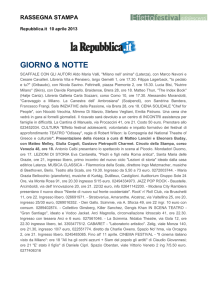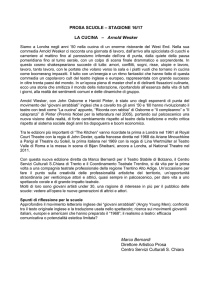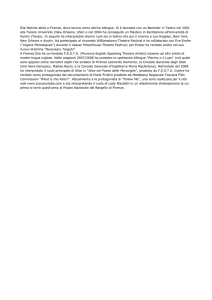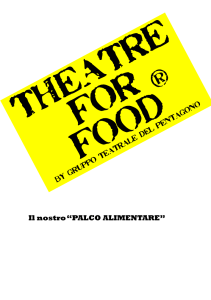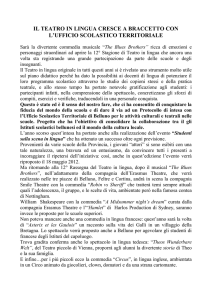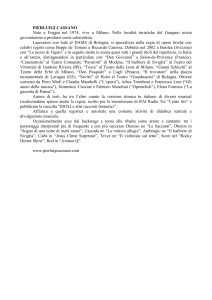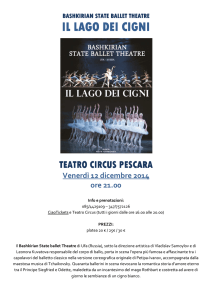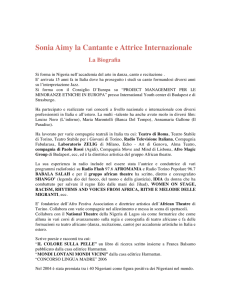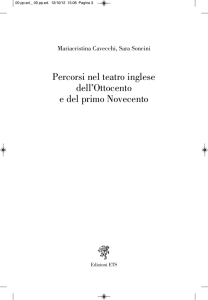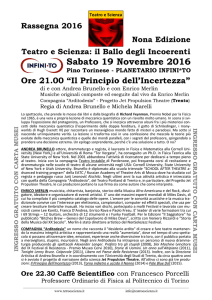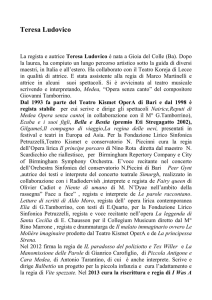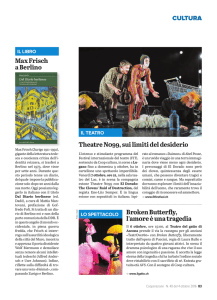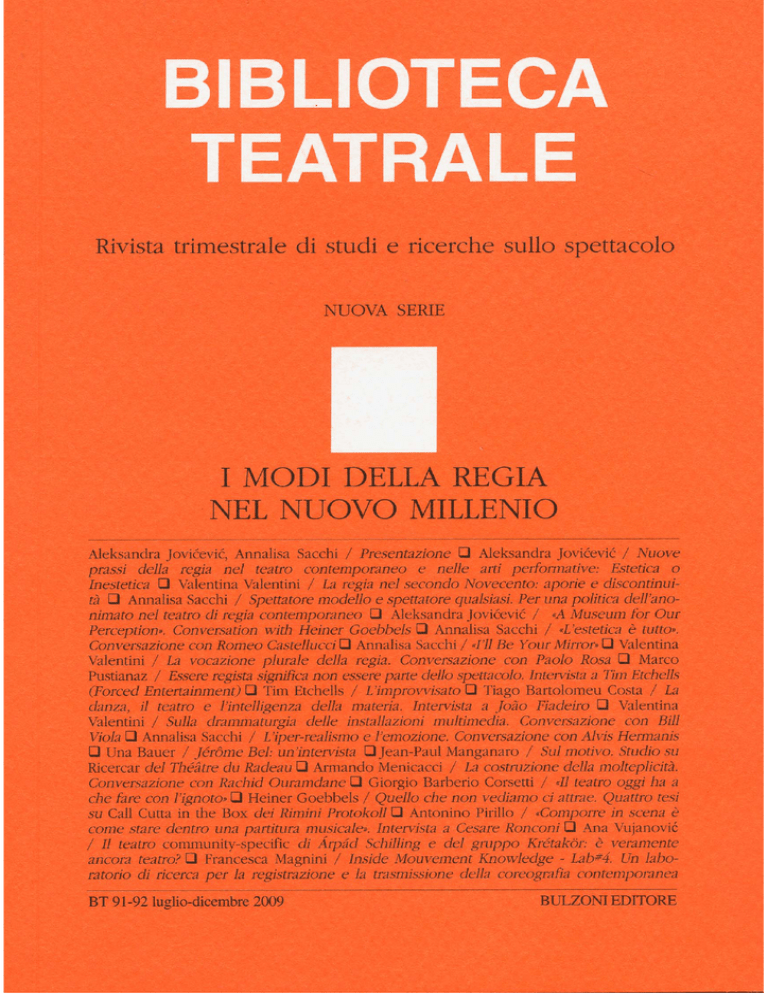
Indice
Sommari ................................................................................................................................... p.
3
Aleksandra Jovićević, Annalisa Sacchi, Presentazione............................... »
21
ANALISI
Aleksandra Jovićević, Nuove prassi della regia nel teatro contemporaneo e nelle arti performative: Estetica o Inestetica............................. »
27
Valentina Valentini, La regia nel secondo Novecento: aporie e discontinuità................................................................................................................................ »
65
Annalisa Sacchi, Spettatore modello e spettatore qualsiasi. Per una
politica dell’anonimato nel teatro di regia contemporaneo....................... »
87
PRATICHE
Aleksandra Jovićević, «A Museum for Our Perception». Conversation
with Heiner Goebbels ......................................................................................................... »
107
Annalisa Sacchi, «L’estetica è tutto». Conversazione con Romeo Castellucci................................................................................................................................................ »
123
Annalisa Sacchi, «I’ll Be Your Mirror»......................................................................
»
135
Valentina Valentini, La vocazione plurale della regia. Conversazione con Paolo Rosa................................................................................................................ »
143
Marco Pustianaz, Essere regista significa non essere parte dello
spettacolo. Intervista a Tim Etchells (Forced Enternaiment)................. »
165
Tim Etchells, L’improvvisato .........................................................................................
181
»
Tiago Bartolomeu Costa, La danza, il teatro e l’intelligenza della
materia. Intervista a João Fiadeiro.............................................................................. p.
185
Valentina Valentini, Sulla drammaturgia delle installazioni
multimedia. Conversazione con Bill Viola ...................................................... »
203
Annalisa Sacchi, L’iper-realismo e l’emozione. Conversazione »
con Alvis Hermanis ..........................................................................................................
219
Una Bauer, Jerôme Bel: un’intervista ................................................................... »
229
VOCI
Jean-Paul Manganaro, Sul motivo. Studio su Ricercar del Théâtre
du Radeau ............................................................................................................................... »
243
Armando Menicacci, La costruzione della molteplicità. Conversazione con Rachid Ouramdane .................................................................................. »
257
Giorgio Barberio Corsetti, «Il teatro oggi ha a che fare con l’ignoto» ..... »
279
Heiner Goebbels, Quello che non vediamo ci attrae. Quattro tesi
su Call Cutta in the Box dei Rimini Protokoll .................................................. »
291
Antonino Pirillo, «Comporre in scena è come stare dentro una
partitura musicale». Intervista a Cesare Ronconi ......................................... »
305
Ana Vujanović, Il teatro community-specific di Árpád Schilling e del
gruppo Krétakör: è veramente ancora teatro?................................................... »
315
Francesca Magnini, Inside Mouvement Knowledge - Lab#4. Un
laboratorio di ricerca per la registrazione e la trasmissione della
coreografia contemporanea ........................................................................................ »
327
SOMMARI
ANALISI
ALEKSANDRA JOVIćEVIć
Nuove prassi della regia nel teatro contemporaneo e nelle arti performative: Estetica o Inestetica
L’ipotesi centrale di questo saggio è che il teatro abbia compiuto un
passaggio e una diffusa trasformazione dal cosiddetto “teatro di regia” del ventesimo secolo al cosiddetto “teatro di non-regia” all’inizio
del ventunesimo. L’autrice usa questo termine in mancanza di un
concetto migliore per descrivere il paradigma emergente dalla natura
interdisciplinare, decentralizzata e collettiva delle nuove prassi direttoriali nel teatro e nelle arti performative contemporanee. Il saggio
discute anche la questione – tuttora aperta – circa la mancanza di
una concettualizzazione sulle diverse implicazioni che questo fenomeno comporta a livello estetico, etico, politico, economico e teorico.
Viene inoltre esaminato diffusamente il lavoro di registi, coreografi,
artisti visuali e performativi contemporanei (Heiner Goebbels, Constanza Macras, Rene Pollesch, Jérôme Bel, Paolo Rosa, Romeo Castellucci, ecc.) indipendentemente dal fatto che il loro lavoro sia direttamente riferibile alla regia, ma precisamente perché esso propone con
particolare intensità una critica ad alcuni elementi costitutivi della
regia teatrale tradizionalmente intesa.
New Directing Praxis in Contemporary Theatre and Performing Arts:
Aesthetics or Inaesthetics
The main hypothesis of this article is that the theatre made a huge
passage and transformation from the so-called “director’s theatre” of
the 20th century to the so-called “non-director’s theatre” at the beginning of the 21st century. The author is using this term for the lack of
a better concept to describe this emerging paradigm: the interdisciplinary, decentralized and collective nature of new directing praxis in
4
Sommari
contemporary theatre and performing arts. The article is also discussing the open question of the lack of concept for all the esthetical,
ethical, political, economic, and theoretical implications that this
phenomenon represents. The article thoroughly examines the work
of contemporary directors, choreographers, visual and performance
artists (Heiner Goebbels, Constanza Macras, Rene Pollesch, Jérôme
Bel, Paolo Rosa, Romeo Castellucci, etc.), regardless of the fact
whether their work properly falls into the category of theatre directing, but exactly because their work proposes with particular intensity
a critique of some constitutive elements of the traditionally defined
theatre directing.
VALENTINA VALENTINI
La regia nel secondo Novecento: aporie e discontinuità
Il saggio prende in esame, a partire dalle istanze di organicità delle
avanguardie storiche, i modi in cui si è declinata la regia nella pratica
teatrale del secondo Novecento. Il montaggio è stato il procedimento
costruttivo di produzione dello spettacolo del nuovo teatro, che nella
scrittura scenica identificava la nuova prassi “registica” autoriale basata sul principio costruttivo del montaggio di elementi autonomi. Il
paradigma della regia, a partire dagli anni Ottanta, viene minato
dall’approccio antropologico e pedagogico e dal postmodernismo, e
al lavoro di composizione dello spettacolo viene anteposto il progetto pedagogico, in una contrapposizione ideologica fra lo spettacolo e
il suo farsi; fra registi demiurghi e registi maieuti.
A partire dagli anni Novanta del Novecento, il processo creativo appare dominato dall’uso di materiali prelevati dalla produzione massmediatica, riciclati e/o assemblati. Proiettandoci verso gli enunciati
più radicali, il saggio prospetta la perdita di ruolo del regista, dell’attore e dello spettatore insieme.
Sommari
5
Directing in the Second Part of 20th Century: Aporias and Discontinuity
The article analyses, staring from the historical avant-garde, the ways
in which theatre directing changed in the second half of 20th century.
Editing has been detected as one of the structural proceedings in
production making of the new theatre, which in the performance
text has been identified as a form of the new authorial “directing”
practice based on editing of autonomous elements. The paradigm of
directing, starting from the 80s, has been undermined by the anthropological and pedagogical approach as well as by postmodernism,
and it seems that pedagogical projects have been favored over the
work on the composing the production, in an ideological counter
position between the production and its making; between directors
as demiurges and directors as maieuticals. Starting with the 90s, the
creative process seemed to be dominated by the materials taken from
mass media, recycled and reassembled. Based on its most radical
representatives, the article is predicting the loss of the role of the director, actor and spectator at the same time.
ANNALISA SACCHI
Spettatore modello e spettatore qualsiasi. Per una politica dell’anonimato nel teatro di regia contemporaneo
L’ipotesi centrale di questo saggio è che il teatro contemporaneo di
regia abbia imposto negli ultimi anni una modalità spettatoriale definibile come “lo spettatore qualsiasi”. Contrariamente all’ipotesi semiotica, e a talune esperienze del modernismo registico, lo spettatore
qualsiasi disattende qualsiasi caratteristica di “perfezione” ed “elettività”. L’esperienza della spettatorialità teatrale si distribuisce in una
moltitudine di soggetti che lo spettacolo cattura attraverso canali patici prima che concettuali. Da ciò deriva anche un mutamento all’interno della trasmissione e della trasmissibilità dell’esperienza della
scena. La soggettività dello spettatore-perfetto-testimone-elettivo del
modernismo, infatti, appare sciolta in una moltitudine, laddove la riproducibilità dell’opera (impossibile a teatro) viene scalzata dalla riproducibilità della testimonianza.
6
Sommari
Model Spectator or Any Spectator: For a Policy of Being Anonymous in
the Contemporary Director’s Theatre
The main hypothesis of this article is that in the last years, a contemporary theatre’s director has imposed a new spectatorship, which
could be defined as “any given spectator”. In opposition to the hypothesis of the semiotics, and based on the experience of many different modernist directors, this every-spectator has both characteristics of a “perfection” and “selection”. The experience of theatre spectatorship is divided into a multitude of subjects, which the production
captures through the experiential rather than conceptual channels.
From this comes out also a mutation inside the transmission and
transfer of the stage experience. The subjectivity of the perfect-spectator-selective-witness of modernism, actually, appears to be dissolved in a group, where the reproduction of the artwork (impossible
in the theatre) comes deprived of the reproduction of witnessing.
PRATICHE
ALEKSANDRA JOVIćEVIć
«A Museum for Our Perception». Conversation with Heiner Goebbels
L’intervista è un tentativo di tracciare la poetica di un compositore e
regista, Heiner Goebbels, il cui lavoro interdisciplinare è difficilmente
classificabile e impossibile da ridurre a qualsiasi definizione semplicistica (non si è infatti certi di aver a che fare con concerti “messi in
scena” o con un teatro musicale o con istallazioni live o con performance multimediali…). In questa intervista, Goebbels afferma che,
quando compone, lavora come un regista e quando lavora alla regia
si comporta come un compositore musicale, focalizzandosi sul ritmo
della performance o sul contrappunto tra elementi visuali e acustici.
Goebbels definisce il suo lavoro come una sorta di Gesamtkunstwerk
nella quale affronta questioni estetiche complesse che hanno a che
fare con la scena, la luce, il suono e il performer, con la relazione tra
il sentire e il vedere, ovvero con la questione generale della percezione e dell’estetica.
Sommari
7
«A Museum for Our Perception». Conversation with Heiner Goebbels
The interview is an attempt to trace the poetics of a composer and
director, Heiner Goebbels, whose interdisciplinary work is difficult to
classify and which is thus avoiding any kind of easy definition (we
are not sure are we dealing with staged concerts or musical theatre
or living installations or multimedia performances, etc.). In this interview, Goebbels claims that when he composes he works like a director and when he directs he works like a composer in musical terms,
on a rhythm of the performance or on the counterpoint between visual and acoustic elements. He defines his works as a sort of Gesamtkunstwerk in which he deals with complex aesthetics that includes
the stage, the light, the sound and the performer, as well as the language and the relationship between seeing and hearing, namely an
overall question of perception and aesthetics.
ANNALISA SACCHI
«L’estetica è tutto». Conversazione con Romeo Castellucci
Romeo Castellucci, membro fondatore e regista della Socìetas Raffaello Sanzio, definisce in questa intervista le modalità che fondano
lo specifico registico all’interno di un lavoro che, dalle sue origini, si
è sviluppato all’interno di un gruppo. La discussione si sviluppa attorno a temi come quello della presenza attoriale, al realismo in scena, alla figura dello spettatore, al montaggio delle immagini specie
nei lavori più recenti del regista, e in particolare nella trilogia ispirata
alla Divina Commedia dantesca. Castellucci si sofferma anche
sull’importanza del principio di locazione in lavori come quelli che
costituiscono la Tragedia Endogonidia, e alle modalità secondo cui
egli orienta, di volta in volta, la scelta del tema ispiratore di un’opera.
«The Esthetics is Everything». A Conversation with Romeo Castellucci
In this interview, Romeo Castellucci, a founder and the director of
Socìetas Raffaello Sanzio, defines various modalities that could be
found in his specific work as a director, which has been always de-
8
Sommari
veloped inside his theatre group. The discussion is built around different subjects like the actor’s presence, stage realism, spectator’s
figure, image-editing, all things that are specific for his latest works as
the director, and especially in the trilogy inspired by Dante’s Divine
Comedy. Special accent is given to the importance of the space in the
works that comprise his Tragedia Endogonidia, as well as to different
ways of the choices he makes, from time to time, of the inspiration
for his art work.
VALENTINA VALENTINI
La vocazione plurale della regia. Conversazione con Paolo Rosa
Paolo Rosa, uno dei membri fondatori del noto gruppo artistico Studio Azzurro, mette a confronto il processo registico con quello della
composizione. La natura interdisciplinare, collettiva e collaborativa di
Studio Azzurro esclude totalmente l’idea che il regista sia l’unico o il
più determinante autore della performance. Al contrario, secondo
Paolo Rosa, il regista è una sorta di artista interdisciplinare, un individuo che sviluppa le idee degli altri, che lavora attivamente su di esse,
traducendole e interpretandole, e che infine le condivide e le negozia
con gli altri collaboratori, di modo che il lavoro finale risulta sempre
dall’atmosfera creativa collettiva. Non importa se talvolta sia ravvisabile una chiara impronta autoriale, l’intenzione originale del lavoro
collettivo di Studio Azzurro non è mai cambiata.
A Pluralist Vocation of Directing. Conversation with Paolo Rosa
One of the founders and members of a renowned Italian artistic
group, Studio Azzuro, Paolo Rosa is comparing the process of directing to composing. The interdisciplinary, collective and collaborative
nature of Studio Azzurro completely overturns the idea of a director
as a single and most important creator of a performance. On the
contrary, according to Paolo Rosa, the director is a kind of an interdisciplinary artist, an individual who processes the ideas of others,
who actively works on them, translates and interprets them, and finally shares and concords them with other collaborators, so that a fi-
Sommari
9
nal piece of work is always a result of a collective creative atmosphere. After 30 years of collaboration, the name of Studio Azzurro
expresses a creative climate based on many and diversified contributions that always lead to a unified one. And no matter if in some cases
there were visible authorial print, their original intention of collective
work never changed.
MARCO PUSTIANAZ
Essere regista significa non essere parte dello spettacolo. Intervista a
Tim Etchells (Forced Entertainment)
In questa intervista con Marco Pustianaz, Tim Etchells, tra i fondatori
del gruppo inglese Forced Enterteinment, definisce il suo lavoro oggi
in relazione alle urgenze compositive e politiche che l’avevano animato all’origine, quasi trenta anni fa. Per Etchells, attivo in una pluralità di forme espressive – dall’installazione alla drammaturgia, alla
narrativa al video – il lavoro registico si compone a partire da una
preliminare condizione: l’essere fuori dalla spettacolo, esserne il
primo e privilegiato spettatore, capace, inoltre, di orientare attitudini,
tempi, sviluppi. Etchells si pone come colui che origina un processo,
indicando temi e problemi, un processo che seguirà poi uno sviluppo parzialmente indipendente, poiché principalmente determinato
dalle individualità coinvolte.
To be a Director Means Not to be a Part of the Production. Interview
with Tim Etchells (Forced Entertainment)
In this interview with Marco Pustianaz, Tim Etchells, one of the
founders of the British theatre group, Forced Entertainment, defines
his present work in the relationship with the structural and political
urgencies that have animated his work almost from the beginning,
thirty years ago. For Etchells, who expresses himself in a number of
art forms, from installation art to dramaturgy, from narration to video,
the work of a director is based on one preliminary condition: to be
outside of the production, and to be its first and privileged spectator,
therefore being capable to manipulate its attitudes, rhythm, and de-
10
Sommari
velopment. Etchells defines himself as someone who originates the
process, indicating themes and problems, the process that will become only partially independent, being at the same time determined
by all the individualities involved.
TIAGO BARTOLOMEU COSTA
La danza, il teatro e l’intelligenza della materia. Intervista a João
Fiadeiro
João Fiadeiro, danzatore, coreografo, regista e fondatore del centro
di ricerca RE.AL a Lisbona, discute in questa intervista le pratiche
compositive che ha sviluppato lavorando a progetti di gruppo o in
stretto contatto con diverse personalità creative: fotografi, artisti visivi, danzatori, ecc. arrivando a definire il problema dell’autorialità come interno alla questione della responsabilità politica della creazione. Le differenti strategie creative applicate al teatro e alla danza
vengono attraversate da Fiadeiro accanto a problemi come quello
della composizione in tempo reale, alla temporalità della scena, al
rapporto col pubblico, al ruolo delle nuove tecnologie.
The Dance, the Theatre and the Intelligence of Matter: Interview with
João Fiadeiro
In this interview, João Fiadeiro, a dancer, choreographer, director and
a founder of the research center RE.AL in Lisbon, discusses various
structural praxis that he has developed within the group, or in a close
relationship with different creative personalities: photographs, visual
artist, dancers, etc., to the point of defining the authority regarding
the question of the political responsibility of the creativity. The different creative strategies applied onto theatre and dance have been
overviewed by Fiadeiro along with the problems such as the composition in the real time, temporality of the stage, as well as the relationship with the public, and the role of new technologies.
Sommari
11
VALENTINA VALENTINI
Sulla drammaturgia delle installazioni multimedia. Conversazione
con Bill Viola
L’oggetto di questa intervista con Bill Viola riguarda la particolare
natura della pratica registica in un campo come quello delle installazioni, assimilato finora all’arte visiva. Studiare la drammaturgia della
produzione più recente di Bill Viola, il processo che va dalla genesi
dell’opera alla sua concreta rappresentazione, significa studiare l’insieme delle scelte estetiche e ideologiche che l’artista nel ruolo di
regista, insieme agli attori e a tutto l’ensemble hanno effettuato. Le
fonti di ispirazione e i temi che l’artista elabora nelle sue opere sono
in gran parte documentati nei quaderni in cui Bill Viola appunta le
sue idee, riflessioni, ossessioni, sotto forma di disegni, storyboard,
pensieri, schizzi, una sorta di sketch diary che accompagna e testimonia la genesi delle sue opere. Da queste note affiora la complessità dei suoi riferimenti culturali: la letteratura mistica orientale ed europea, antichi testi hindu e buddisti, il pensiero Zen, le pratiche artistiche degli anni Settanta, il cinema sperimentale, l’ambient music…
Nel suo lavoro, arte e vita, etica ed estetica sono interrelati, nel senso
che Bill Viola crede alla funzione pragmatica dell’arte, alla sua capacità di modificare le esistenze delle persone, come un rituale o una
immagine sacra, rispetto alla quale il fedele si raccoglie pregando.
On the Dramaturgy of Multimedia Installations. Conversation with
Bill Viola
The object of this interview with Bill Viola is the particular nature of
directing within the installation art, which until now exclusively belonged to visual arts. To study the dramaturgy of Bill Viola’s recent
productions means to study them from the conception of an idea to
its concrete realization, as well as the esthetic and ideological choices
that the artist, now in the role of director, is making together with the
actors and the rest of the ensemble. The source of inspiration and the
themes the artist elaborates in his work are in large part documented
in the notebooks in which Bill Viola puts down his ideas, thoughts,
obsessions, in a form of designs and storyboards, or sketches, repre-
12
Sommari
senting a kind of sketch diary that accompanies and witness the genesis of his artwork. From these notes one can detect a complexity of
his cultural references: mystical oriental and European literature, old
Hindu and Buddhist texts, Zen philosophy, artistic practices of the
70s, experimental movies, ambient music… Both in his art and life,
his ethics and esthetics are interpolated in a sense that Bill Viola believes in a pragmatic function of art, its capacity to modify the existence of people, as a ritual or sacred image, in front of which a believer bows to pray.
ANNALISA SACCHI
L’iper-realismo e l’emozione. Conversazione con Alvis Hermanis
Con Alvis Hermanis il teatro cresciuto e diffuso nell’orbita della tradizione dell’ex Unione Sovietica si miscela con immaginari e pratiche
molteplici, dalla performance art al teatro musicale. Attivo a livello
internazionale, il regista presenta un regime di creazione accelerato
che gli permette di lavorare a diverse produzioni ogni anno, in molteplici paesi e confrontandosi con tradizioni attoriche e teatrali anche
lontanissime tra loro. Il lavoro con la sua compagnia stabile, basata a
Riga, è definito centrale da Hermanis che propone l’idea di una pratica registica collaborativa, fortemente appoggiata sulle proposte degli
attori.
The Hyperrealism and the Emotion. A Conversation with Alvis Hermanis
In the work of Alvis Hermanis, a Latvian director, the theatre that
came to being and was developed within the tradition of the ex-Soviet Union, is mixed with multiple imaginaries and practices, from
performance art to musical theatre. Well known within the international community, this prolific director comes out each year with different productions, in different countries, therefore confronting himself with diversified acting and theatre traditions. Hermanis defines
the work within his repertory theatre based in Riga, as central for
him, because he considers his directing practice a result of collaboration, which depends immensely on the ideas of the actors.
Sommari
13
UNA BAUER
Jérôme Bel: un’intervista
Un coreografo e danzatore concettuale, Jérôme Bel, che afferma di
non aderire a nessuna di queste categorie, parla del suo inconfondibile modo di lavorare con la sua propria identità e col suo corpo,
così come con le identità e coi corpi degli altri danzatori. Bel descrive
il suo lavoro sperimentale e minimale degli ultimi vent’anni, che
rappresenta allo stesso tempo una critica radicale della danza classica
e moderna. L’intervista esamina l’idea centrale della sua ricerca, ovvero l’investigazione su ciò che accade quando un danzatore sospende la danza nella performance e tratta, allo stesso tempo, della relazione particolare che Benjamin intrattiene con il pubblico che deve
accettare questo genere di non-danza.
Interview with Jérôme Bel
A conceptual dancer and choreographer, Jérôme Bel, who claims to
be nothing of these, talks about his unique way of working with his
own identity and body as a dancer, as well as with the identities and
bodies of other dancers. He talks about his minimalist and experimental work in the last twenty years, which represents also a strong
critique of classical and modern dancing. The interview examines the
central idea of his work, which is an investigation on what happens
when a dancer suspends dancing altogether from a performance and
also deals with Bel’s particular relationship with the audience, who
has to accept this kind of non-dancing.
14
Sommari
VOCI
JEAN-PAUL MANGANARO
Sul motivo. Studio su Ricercar del Théâtre du Radeau
Il lavoro di Tanguy e del Théâtre du Radeau è tra i casi più interessanti nel panorama del teatro di regia francese. In questo saggio
Manganaro, da anni osservatore e critico attento dei lavori del gruppo, analizza la politica di elaborazione di spettacoli come Coda,
Cantates, Ricercar. In particolare Ricercar diviene occasione per
un’analisi che, attraverso la definizione del luogo-spazio attraversato
dalla presenza plurale dei corpi, giunge a dettagliare il rapporto di
Tanguy con l’ironia, con la drammaturgia, con l’uso dell’illuminazione e con i vari elementi che concorrono alla creazione del testo
spettacolare. Il focus centrale coincide con l’analisi dell’uso della
prospettiva – in funzione polemica con l’uso canonico previsto dal
teatro –, come elaborazione stilistica e come forma simbolica, in Ricercar.
On the motive. A Study on Ricercar of the Théâtre du Radeau
The work of Tanguy and the Théâtre du Radeau is one of the most
interesting cases in the panorama of the French theatre directing. In
this article, Manganaro, who for years has been following their work
with critical attention, analyzes the politics of creation their productions, such as Coda, Cantates, and Ricercar. Especially Ricercar
seems to be a good case study for a thorough analysis, through the
definition of space-place relationship, filled with bodies, enabling a
detailed description of Tanguy’s relationship with irony, with dramaturgy, with the use of lights and with the use of different elements
that contribute to the creation of the performance text. The central
focus coincides with the analysis of the use of prospective – in polemic function with the canonical use expected in the theatre – as a
stylistic elaboration and as a symbolic form in Ricercar.
Sommari
15
ARMANDO MENICACCI
La costruzione della molteplicità. Conversazione con Rachid
Ouramdame
Rachid Ouramdame, coreografo e danzatore tunisino basato in Francia,
descrive la sua pratica creativa come orientata verso un atteggiamento
militante per promuovere e mostrare le differenze. Nel suo lavoro, le
scelte estetiche e politiche dipendono anche dal contesto geografico in
cui l’opera nasce e si sviluppa. Il rapporto col repertorio della danza
occidentale e con la tradizione in generale diviene occasione per una
riflessione sulla portata e la moltiplicazione delle immagini di morte
nella società contemporanea. Ouramdame si sofferma inoltre sulle
questioni dell’identità pubblica e della vita interiore, che serpeggiano
costantemente nella trama dei suoi lavori, rifrangendosi nella pratica
compositiva che include autorialità ulteriori rispetto alla sua.
The Construction of Multiplicity. A Conversation With Rachid
Ouramdame
Rachid Ouramdame, a Tunisian choreographer and dancer, who
works in France, describes his creative practice as oriented toward a
militant stand in order to promote and demonstrate the differences.
In his work, his esthetic and political choices depend also on geographical context in which an art work is born and developed. The
relationship with the repertory of Western dance and general tradition becomes an occasion for the contemplation on the nature of the
images of death in contemporary society. Ouramdame is also offering
thoughts on the public identity and interior life, themes that can be
seen constantly in his work, and is reflected in his practice that includes authorities other than himself.
GIORGIO BARBERIO CORSETTI
«Il teatro oggi ha a che fare con l’ignoto»
In questa intervista Giorgio Barberio Corsetti sostiene di non lavorare
mai a una messa in scena classica, quanto piuttosto su un testo performativo, creato attraverso una geografia di corpi, movimenti e
16
Sommari
all’interno di un vasto territorio composto di leggende e mitologie.
Inoltre, Corsetti lavora con immagini, o più precisamente con idee
che diventano immagini attraverso il processo compositivo della
performance alla quale esse rimangono costantemente connesse. Il
cosiddetto primo livello d’immagini e testo performativo è condotto
verso una rete di significati che aprono verso un diverso significato,
un altro universo che è un luogo immaginifico, sede del subconscio,
spazio oltre la vita stessa, qualcosa di completamente sconosciuto,
che è significativo per la esplorazione nel teatro.
«The Theatre Has Something to Do With the Unknown»
In this interview, Giorgio Barberio Corsetti, claims that he never
works on a classical mise-en-scène but rather on a performance text,
which is created through a geography of bodies, movements and a
vast territory made up of legends and mythologies. In addition, he
works with images, or more precisely with the ideas that become
images through a process of performance making and which are, all
the time, related to it. The so-called first level of images and performance text are brought into a network of meanings that open up yet
to another meaning, another universe, which is a place of imagination, of subconscious, of something beyond life itself, something that
is completely unknown and is worth exploring in the theatre.
HEINER GOEBBELS
Quello che non vediamo ci attrae. Quattro tesi su Call Cutta in the
Box dei Rimini Protokoll
In questo testo l’artista Heiner Goebbels descrive la sua esperienza di
spettatore di una delle più emblematiche performance dei Rimini
Protokoll, Call Cutta, (2005). Al posto del biglietto, ogni membro del
pubblico riceveva un telefono cellulare e veniva condotto per le
strade di Berlino da una voce proveniente da un call center in India.
Sebbene la performance non producesse alcun evento spettacolare,
né scenografico né attoriale, Goebbels la definisce molto più stimolante, sotto una prospettiva artistica e per il suo impegno politico,
che qualsiasi altra opera vista da lui a teatro, perché capace di stimolare una riflessione sulla natura specifica della performance teatrale.
Sommari
17
What We Don’t See Is What Attracts Us. Four Theses on Call Cutta in
the Box of the Rimini Protokoll
In this text, the artist Heiner Goebbels describes his unique experience of a spectator in one of the Rimini Protokoll’s most unusual
performances Call Cutta (2005). Instead of the ticket, each member
of the audience received a mobile telephone and was supposed to
be navigated through the streets of Berlin by a voice from a call center in India. Even though the performance did not offer spectacular
events, no acting, no set design, it affected Goebbels as more stimulating and artistically and politically engaged than any other piece he
saw in the theatre, because it made him reflect about the nature of a
theatre performance itself.
ANTONINO PIRILLO
«Comporre in scena è come stare dentro una partitura musicale». Intervista a Cesare Ronconi
Cesare Ronconi, fondatore con Mariangela Gualtieri del teatro Valdoca, definisce il suo lavoro in rapporto al lavoro con gli attori, alla
creazione delle figure che abitano la scena, e in particolare alla ricerca che da anni conduce sulla voce, che deve rendersi duttile per dire
la poesia della Gualtieri. Il corpo dell’attore si fa materia per la scrittura del testo, portando i membri del gruppo a lavorare a stretto
contatto sin dalle fasi iniziali di ogni progetto scenico. Ronconi si
sofferma inoltre sulla questione del volto dell’attore, dell’uso di colori
che, in maniera ricorrente nei suoi spettacoli, mascherano le fisionomie individuali conducendo i soggetti a un’iniziazione verso il divenire-altro che porteranno in scena.
«To Compose on the Stage is Like Being in a Musical Score». Interview
with Cesare Ronconi
Cesare Ronconi, who together with Mariangela Gualtieri has founded
Valdoca theatre, defines his work in the relationship with actors, during the process of creating the figures that inhabit the stage, and especially in the research, which he has been conducting, for years, on
the voice that has to be adjusted for the poetry of Gualtieri. The body
18
Sommari
of the actor becomes a base for the text writing, which brings the
members of the group to work closely with one another from the
beginning of each stage project. Ronconi also discusses the face of
the actor and the use of colors, which are constantly used in his productions, as masks to cover individual faces, in a form of initiation of
becoming someone else on the stage.
ANA VUJANOVIć
Il teatro community-specific di Árpád Schilling e del gruppo Krétakör:
è veramente ancora teatro?
In questo saggio Ana Vujanović, tenta di rispondere ad alcune questioni poste da Árpád Schilling (Krétakör group), noto per le sue
performance community-specific. Negli ultimi due anni il Krétakör
Theatre sta lavorando su un problema centrale: come può incidere il
teatro sulla comunità che considera come il suo pubblico? Il teatro
rappresenta un incontro diretto, l’arte dell’interazione, un momento
inimitabile di fronte a un pubblico la cui composizione è ogni volta
unica. Per questo motivo Schilling afferma di dover comprendere e
sviluppare nuove leggi e modelli creativi che assumano la comunità
come punto di partenza e obiettivo finale. Nella maggior parte delle
sue produzioni, il contatto diretto con gli spettatori è inderogabile e
richiede un coinvolgimento personale da parte degli attori. Poiché il
pubblico può interrompere la performance, l’attore deve essere in
grado di produrre una risposta efficace, che include la decostruzione
dei limiti del ruolo, una risposta cioè capace di creare una relazione
con lo spettatore.
Community-specific Theatre of Árpád Schilling and Krétakör group:
“Is This Really a Theatre?”
In this article, Ana Vujanović, is trying to answer some questions
posed by Árpád Schilling and Krétakör group, famous for their community-specific performances. In the last two years, Krétakör Theatre
is working on a central question: how does the theatre, affects the
community which it considers as its audience? Since the theatre represents a direct encounter, the art of interaction, an inimitable mo-
Sommari
19
ment before an audience of inimitable composition, Schilling is
claiming that he must understand and develop new laws and modes
of creation that take community as its starting point and a final goal.
In most of his productions, the direct contact with the viewers is unavoidable, which requires more personal involvement from the actors. If the audience can break the performance, than the actor must
be able to make a relevant answer, which involves disassembling the
limits of the role, in other words, building a link with the spectator.
FRANCESCA MAGNINI
Inside Movement Knowledge – LAB#4. Un laboratorio di ricerca per
la registrazione e la trasmissione della coreografia contemporanea
Questo saggio intende indagare le più recenti strategie di analisi del
movimento per la documentazione della danza. Un team di ricercatori
legato alla compagnia diretta dal coreografo italiano Emio Greco e dal
regista-drammaturgo olandese Pieter Scholten (EG | PC) nell’Aprile
del 2010 si è riunito ad Amsterdam presso l’International Choreographic Arts Center (ICKamsterdam) per far fronte a diverse lacune
riguardanti i metodi di notazione al momento esistenti. Le collaborazioni interdisciplinari nate in seno al progetto triennale Inside Movement Knowledge hanno consentito di testare un’installazione chiamata
Double Skin/Double Mind, progettata appositamente per simulare la
situazione d’apprendimento di un workshop e facilitare l’individuazione/riproduzione di un preciso vocabolario gestuale. Il caso analizzato
in questo saggio può costituire un punto di partenza per parlare delle
difficoltà di conservazione e trasmissione del repertorio, incontrate
frequentemente dalle compagnie di danza contemporanea.
Inside Movement Knowledge – LAB#4. A Laboratory for the Research
of Registration and Transmission of the Contemporary Choreography
The intention of this article is to investigate the most recent strategies
for the analysis of the movements in the dance documentation.
A team of researchers, who work with a company led by Italian choreographer, Emio Greco and by Dutch director-dramaturge Pieter
20
Sommari
Scholten (EG | PC), met at Amsterdam based International Choreographic Arts Center (ICKamsterdam) in April 2010, to discuss different
lacunas in the existing methods of dance notation. The interdisciplinary collaboration born within a triennial project, Inside Movement
Knowledge, has been created to contest an installation entitled Double
Skin/Double Mind, planned on purpose to simulate the situation of
learning in a workshop and to facilitate the individuation/reproduction
of a precise movement vocabulary. The case study analyzed in this
article can represent a starting point for talking about the difficulties
of conservation and transmission of a repertory that are frequently
faced by the contemporary dance companies.

